CHATTANOOGA - Hundreds of freshwater fish, mussels, crawfish and salamanders - many of them found nowhere else in the world - make their home in the U.S. Southeast. In one waterway alone, Tennessee's Duck River, there are more fish species than in all of Europe.
But the species that creep, crawl and swim in these rivers and streams are also some of the most endangered on the planet, because much of the land those waterways flow through is in private hands with little protection.
Tennessee Aquarium Conservation Institute is the only research facility in the Southeast with a primary focus on saving freshwater animals. Until now, it has operated out of offices spread across the aquarium's Chattanooga campus. But it is expanding this fall, with a new building equipped with research and teaching labs. Supported by admission, corporate gifts and grants, the nonprofit is working in states throughout the Southeast to both protect and draw public attention to these oft overlooked species.
"We are surrounded by an underwater rainforest," said Tennessee Aquarium Conservation Institute Director Anna George. But unlike tropical rainforests, which most schoolchildren know are both full of life and threatened, few Americans are even aware of the rich diversity in their backyards - or the number of extinctions taking place there.
"If people aren't appreciating what we have, they're not going to take the time to protect it," George added.
But saving species is complicated.
Take the improbable task of training a minnow to fear a predator. The 3-inch-long barrens topminnow is native to the headwaters of the Duck, Elk and Caney Fork rivers in Middle Tennessee. Already it can no longer be found on the Elk.
The problem? The western mosquitofish was introduced to the topminnow's habitat to eat mosquito larvae, but it also likes the topminnow larvae and young fish.
The aquarium has bred and released more than 22,000 barrens topminnows, but they are still disappearing.
Now they're trying to train the minnows to survive.
"We had a barrens topminnow in a tank and we put in a western mosquitofish at the exact same time we put in a chemical alarm cue," said Sarah Farnsley, a biologist who performed the research as a graduate student. There was also a group of control fish that weren't exposed to the chemical alarm.
All the fish were then marked and released into the wild. Days later, Farnsley went back to the spring and dragged a seine net through the water, recapturing three conditioned minnows and none from the control group. It doesn't prove the conditioning worked, but it was a promising result.
"That was a good day for me," Farnsley said.
Habitat loss is the biggest challenge for many of the Southeast's endangered freshwater animals. Though the Duck River has more fish species than all of Europe, according to the Nature Conservancy and NatureServe, the future of those creatures is anything but certain.
Matt Hamilton, who breeds the minnows at the aquarium, said it's a challenge having so much native habitat on privately held land: "An owner might say, 'Hey, this is my spring. I want to put me a bass fishing pond here.' That happened to one of our topminnow sites."
George estimates about 90 percent of the institute's research and conservation work takes place on private land.
While the aquarium and the conservation institute don't protect rivers and streams directly through land purchases or easements, they are working to raise awareness of what's in the water that's worth saving.
Land owners are "amazed by the little things we pull out of the water, all the colors," she said.
With the upcoming expansion, George says she ultimately wants the institute to become to freshwater research what the famous Woods Hole Oceanographic Institution is to marine research. And she plans to keep educating the public about the treasures in their back yards. The institute is even supporting the development of canoe and kayak trails, called blueways, so people get to know the local rivers.
"What if everyone could name five fish in the river below them?" she asks. "That would be awesome!"


